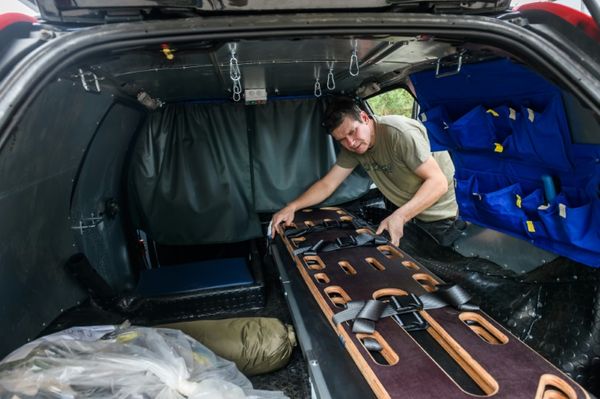
The heavy fog that cloaked Gaza’s agony on the morning after Israeli troops arrived was burned away by the sun – only to be replaced by the smoke of hundreds of bombs, and between the blasts, there was a new sound: machine gun fire.
The sporadic rattle coming from the northern town of Beit Hanoun could be heard from a hillside five kilometres away, across the border in Sderot, audible proof that the Israeli troops who crossed into Gaza on Friday night were still there on Saturday. The taking of Gaza territory had begun.
It was not an all-out invasion, at least not yet, but nor was it the sort of in-and-out incursion of the sort the Israel Defence Forces (IDF) had performed on the preceding nights.
“What’s notable to me, is also that for the first time since the Hamas surprise attacks on October 7, we’re seeing efforts by Israel to stay in some areas of Gaza, particularly the north, possibly to locate and destroy tunnels, or [to find] hostages,” Michael Horowitz, head of intelligence at Le Beck International risk consultancy, said.
The ratchet has been turned up, and Israel’s defence minister, Yoav Gallant, made clear on Saturday it would continue to turn.
“We attacked above the ground and underground, we attacked terror operatives of all ranks, everywhere,” Gallant said in a video statement. “The instructions for the forces are clear: the operation will continue until a new order.”
That “new order” means a world without Hamas, the stated goal of Operation Swords of Iron. But it will also be a world without thousands of Palestinian civilians, trapped in the wreckage of Gaza.
The eastern side of Beit Hanoun visible from Sderot had ceased to resemble any sort of human habitation. Residential blocks had been pulverised, and the pounding focused on Jabalia refugee camp south-west of the town, and Gaza City beyond that.
Self-propelled howitzers, massive guns on tracks dug into the farmland to the south, fired every minute or two. Blasts of what sounded like tank fire could be heard from inside Beit Hanoun, and every few minutes the roar of a jet would pass over to be followed by a bloom of white smoke on the horizon.
The Israeli army is well aware it is marching into a trap, that its lines of advance will be mined and booby trapped and that Hamas fighters with Russian-made Kornet anti-tank missiles will be waiting in the rubble. But the IDF plan is to obliterate the trap first, turn alleyways into flat boulevards through relentless bombing.
Since it gave instructions for Palestinians in Beit Hanoun and the rest of northern Gaza to move south, it has told itself that whoever remains has chosen to be a human shield for Hamas, no matter if they are too old or sick to move, or that up to now, the south has been as deadly as the north.
The first day of the ground assault did not show definitively how Israel will seek to achieve its stated aim of destroying Hamas militarily and politically, but it provided clues.
Amos Yadlin, a former head of Aman, the IDF intelligence directorate, said that Friday night’s incursion was intended in part to demonstrate that Israel would not hold back its military plans while Hamas released its more than 220 hostages at a rate of two per week.
“If you do the math, that would take two years and Israel is not accepting that,” Yadlin said. “This is to tell [Yahya] Sinwar [the Hamas chief inside Gaza] you are not going to stop the [ground offensive] and you are going to pay even more if you are not going to do a serious and substantial deal.”
Yadlin said that the ground incursion was just the beginning of months of “low-intensity conflict”, pursuing Hamas through the deep tunnels it has underground.
Avi Melamed, another former Israeli intelligence official, agreed that the incursion was not necessarily the prelude to an all-out offensive, but the first of many limited operations that would steadily escalate.
“It is not a full-steam charge of all the army from all directions,” Melamed said. “It is more a modular approach, chewing away at Hamas towards its centre.”
Yadlin said that the success of the offensive would depend on how much time Israel had. If it had five weeks, Hamas would be severely depleted but would hang on in Gaza, and would be regularly targeted in the coming years by Israeli strikes to stop it rebuilding a military capacity.
If the IDF had five months, Yadlin predicted, it could rid Gaza of Hamas altogether.
Israel had to do what was necessary to prevent anything like the 7 October attack ever happening again, he said, including redrawing the map of the Middle East.
“We will never go back to the 1967 lines, because these proved to be unprotectable,” he said. “If we want the kibbutzim and the towns of the western Negev to come back, we need a buffer zone. We need our enemy to understand that such aggression will cost them in territory as well.”
How much time Israeli forces have to achieve their aims will depend on the international climate, and in particular, US tolerance for the price in civilian lives of the Israeli offensive. On Saturday, it was announced that the three-star US Marine Corps general James Glynn, sent to sit alongside Israel’s commanders in the IDF war room, had left the country.
“Make no mistake – what is, has or will unfold in Gaza is purely an Israeli decision,” the Marine commandant Gen Eric Smith, said, announcing the departure. “[Glynn] was over, he’s back now and he provided his experience to be taken [or] not taken.”
The US had urged restraint, for Israel to hold back on a ground offensive, and Smith’s remarks suggested that advice had been ignored, and what unfolds now is no longer Washington’s responsibility.
By the time Israeli troops had entered Beit Hanoun however, it may already have been too late for that.







